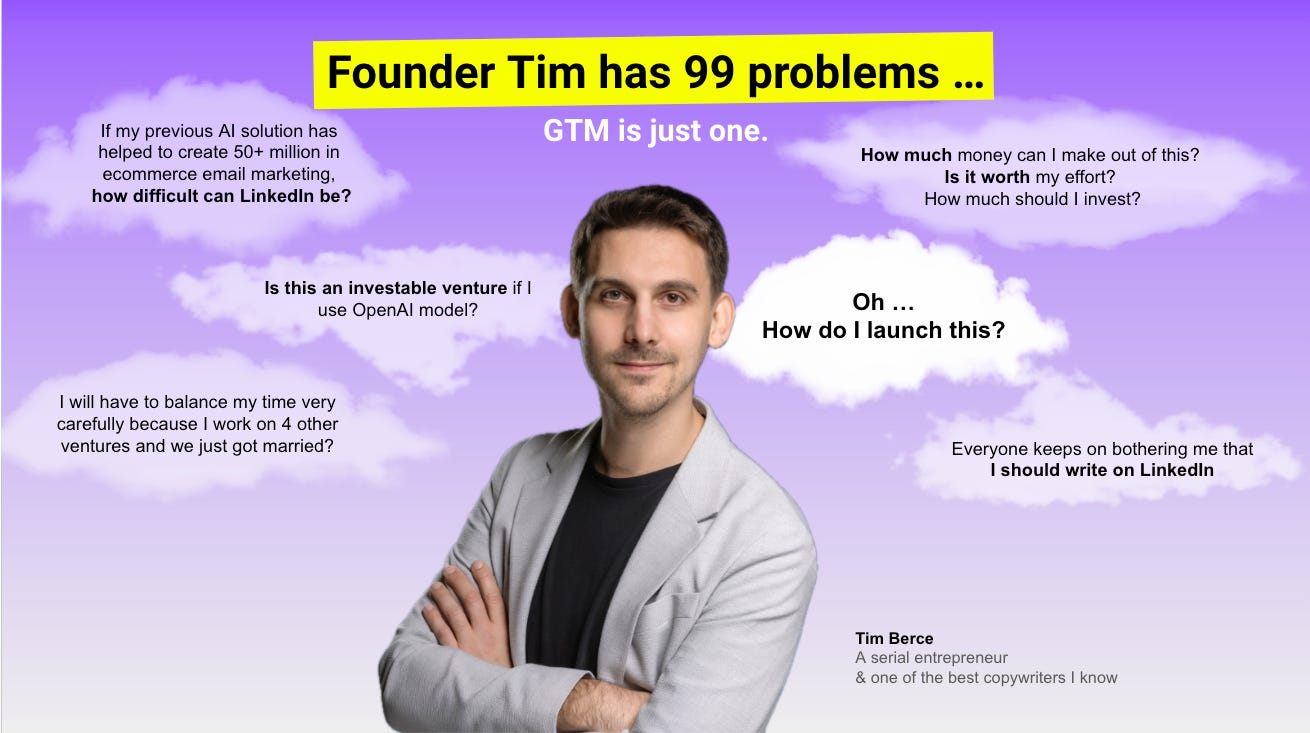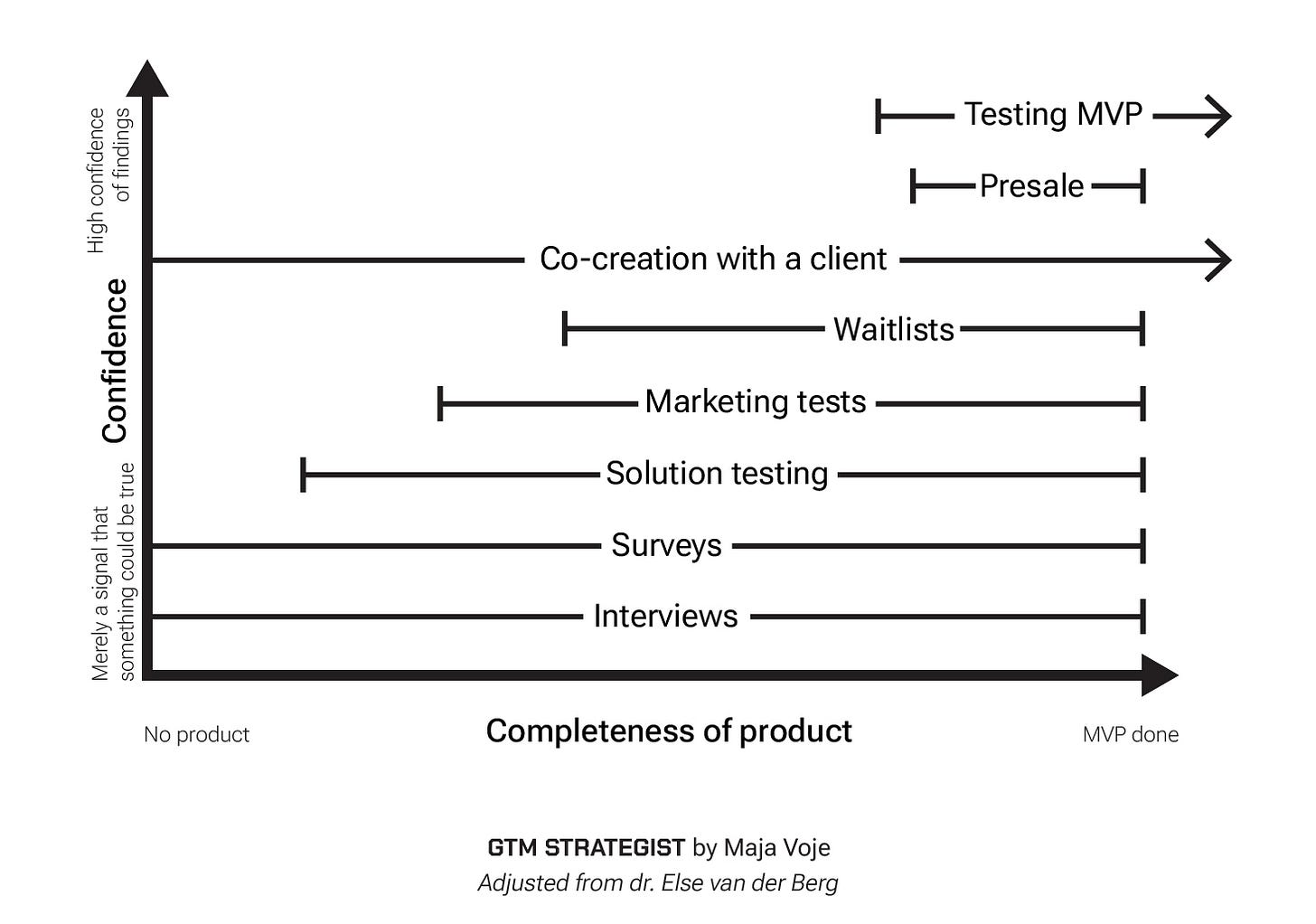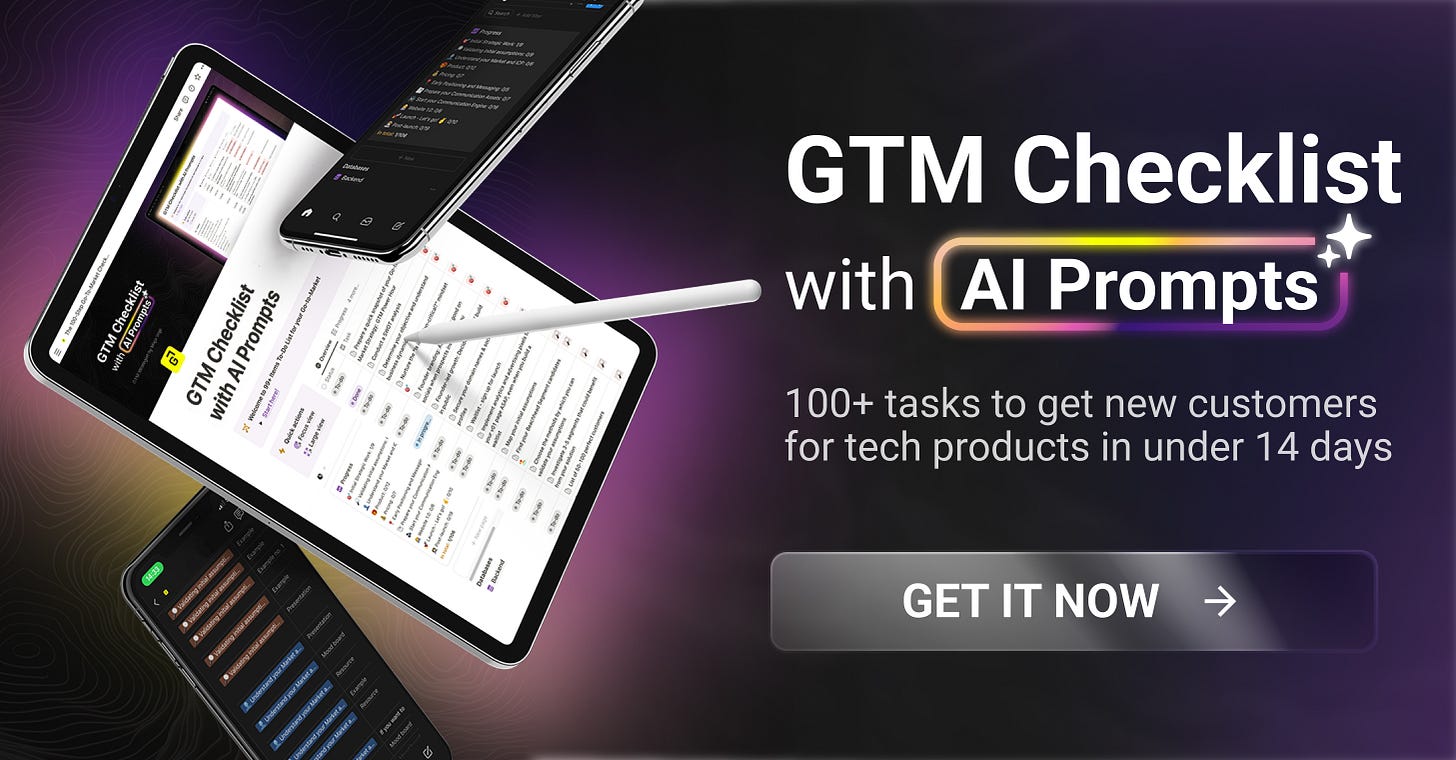My 7-Day Business Idea Validation Framework
Actual case study for an AI chatbot: 21 hours of work, $20 budget
Dear GTM Strategist!
I hope that 2025 started great for you. For the new year, I made one BIG commitment: Launch my very first AI product.
Initially, I thought Q1 would be dedicated to validating the use case. You know - doing 30 interviews, prototyping, running a use case workshop with a field expert, investing min. $30K into the product … until I asked myself: is that necessary?
Why should I impose traditional methodologies and fictional timelines on my validation process?
Since I found very few reasons to justify the initial thought, I turned back to one of my best friends - rapid experimentation - and went on a mission:
Can I build a prototype, get at least 100 relevant users to test it, and find good insights to narrow down my value proposition to a single use case in less than a week?
I present my 7-Day Business Idea Validation Framework, which I used for three hours a day for seven days before Christmas to validate one of my big strategic bets for 2025.
My 7-Day Idea Validation Framework

Now, let’s dive right in!
DAY 1: Lead with your vision and market insights
Every excellent product journey starts with the inception of a big vision. What do you see/know that others do not? If you think about entrepreneurship as creative problem-solving, you must start with understanding the environment: what is good and what needs improvement.
Framework I used: SWOT analysis
If you are as unimpressed with spending a lot of time doing macro market analysis as I am, a simple SWOT analysis will help you grasp the main opportunities and threats and realistically value them against your strengths and weaknesses.
Better yet, drive the inspiration from your business practice. What is the problem that you have solved before? How to tweak a solution that would help many more people?
In my 15 years of experience, I have built thousands of GTM strategies as a consultant. I know the process inside out, and I have spent two years creating knowledge assets (digital products, book, Substack posts, workshops, LinkedIn posts) to help people navigate the process of building a GTM strategy. However, my time and bandwidth are limited; and reading or watching the materials is not always the most effective way for my audience to get the specific answers they need for their business.
My vision is to bring you actionable answers in seconds instead of encouraging you to follow me on LinkedIn or read 350 pages of a book to find something suitable for you. This was my big inception in 2024 - and AI has opened new ways for me to deliver you value more effectively: faster, better, more tailored, cheaper. This is the frontier I have to conquer.
DAY 2: Define minimum viable segment - Early Customer Profile (ECP)
After the initial product inception, I have to find the Early Customer Profile for my new launch. Who can benefit most from the value delivery mechanism I have in mind? When selecting this profile - also called the Beachhead Segment - I have four characteristics in mind:
A burning pain point - this problem needs to be solved now.
Sufficient willingness to pay - AI model costs money to run. I need to think about the business model as soon as possible. Who has the resources and willingness to pay becomes a mission-critical question when you are bootstrapping.
My proximity to the segment - based on my previous work and network, I need to select an ECP that I can realistically win a significant proportion of the market in the next 3 months that I can invest in this project. I want to play where I can win, also considering the competitive solutions in the space.
This segment needs to create relevant case studies, testimonials and sufficient amount of reviews. It will be a proof that my product works so that I can continue to move upmarket later and use social proof in my marketing and sales.
Frameworks I used: Market-Problem Map and problem space visualization.
To bring all the information together, I used the Market-Problem Map framework developed by Simon Belak, data scientist and CTO (prev. Zebra BI, Metabase), and visualized my ECP’s problem space with a nice visual that guides my decision-making, nurtures empathy and inspires me to do my very best to help this person.
DAY 3: Create value proposition
I could potentially solve many of my ECP's problems, but I know from my business practice that the best niche AI products serve a narrow audience and use case. I had to narrow down my value proposition to my target audience. In the broadest aspect, I am “helping Tim to do marketing/launch/sales aka GTM” (his words, not mine) and he needs assets, not more theory, to get things done.
That led me to believe that a perfect use case I will select is:
Highly tactical - do something that has immediate added value for ECP.
Low time to value - he can grasp it in seconds and apply it in hours (better minutes). You do not send people to commit to some long-term distant-goal tasks if you want the probability of the wow effect to emerge sooner.
I also generated intelligence from my business practice what were the most frequent service requests from the founders I worked with for implementation - what would they outsource.
Framework I used: Value Proposition Template by Paweł Huryn and Aatir Abdul Rauf
To get more tactical, I used Value Proposition Template to refine my thinking about the problem space I previously tackled to jobs to be done by my selected ECP. I believe great products are transformational in terms of bridging the gap between the current state, which is imperfect and painful for ECP, to a desired future state where the customer is better off.

Here, I inevitably bumped into a positioning problem (next step): how else can Tim solve his marketing/sale/launch problems? What are the competitive alternatives I have to fight against?
DAY 4: Minimum viable positioning
My ECP (let’s continue to call him Tim) would naturally lean towards DIY-ing this based on some templates. The problem is that most templates were not tested on businesses of his size and industry. Tim is also a highly time-sensitive person since his time has a serious opportunity cost. He could go ahead and hire a freelancer or smaller agencies. The challenge is that he will find it incredibly hard to find someone with a proven track record in his niche at the budget he has in mind, plus he does not really like meetings and managing people/handling onboarding.
As long as I can make something that is comparable with the quality of non-field-expert, lower-fee service providers within a fraction of the time and effort that Tim has to put into this - I could have a winning product.
Framework I used: Competitive alternatives scoring by Andrej Peršolja

Based on identifying my differentiations, I developed my UVP (Unique Value Proposition, your promise to the customer):
Get actionable go-to-market assets in seconds
And these were my Unique Selling Propositions (USPs, “why this solution”):
Methodology tested on 8000+ companies
Trained on 1 million characters proprietary knowledge base including a best-selling book GTM Strategist
It is for free - the max you can lose is 3 minutes of your time. Is it worth a shot?
But what exactly to focus on - landing pages, ads, emails, presentations …? I need to do one thing really well before potentially exploring other use cases. Focus is the name of the game when we are creating AI agents in small teams. ✌️
Do not guess - test!
DAY 5: Select the validation method
People do > People say.
I needed rapid validation with high confidence. Here is my reasoning for why I feel much more confident about this way of validating the products than following the traditional blueprint:
For this product, I am “eating my own dog food” and innovating for the existing audience, which I know inside out - I spend 30 hours a week with them working on specific challenges.
It is easier than ever to deploy prototypes, and no-code tools and agent builders have made it more accessible than ever to build prototypes.
There is a knowledge asymmetry between makers and users of innovative solutions. You have to teach and lead by example, or even better: case studies with proven results. Give your audience ideas on how you can elevate their business.
By no means am I underestimating my audience. Still, the fact is that we are learning by doing together in this stage of technology, and if I solely relied on my target audience's imagination of what the product could be. As a maker, I have to bring the element of a product vision and unique methodology to solve this problem to the equation.
We are all limited by time and resources. I want to make it in a way that will radically decrease time to value because speed is of the essence in innovation. The sooner I can get real people to use it, the better.
Framework I used: Adjusted Validation Methods framework by dr. Else van der Berg
I decided to do a soft launch on LinkedIn because the majority of the ECP audience is there. I didn’t do an email blast (which could produce way better results) or launch with influencers like I do for the main launches because there was no need to get thousands of users in this iteration of the product just yet. It would not be fair to hype it more because it is a test build, not a polished product that I can absolutely stand by and guarantee that it will work amazingly well for you. As such, it does not deserve a full blast just yet.
If you don’t have the audience to launch to, some of my teams used social media groups relevant for their ECP, cold outreach (emails), and ads to achieve the same and, in some cases, even better traction. If you can build it - you can test it. No excuses.
DAY 6: Idea validation experiment design
The validation methods that were appropriate to me were marketing tests and product tests. We built a beta version of the business idea (not the final product) based on my existing assets with a no-code tool, tested it, improved the core prompts, and launched it. Huge thanks to Ihor Dervishov, the maker of Elsa ICP identifier, for helping us put this build up in less than 3 hours. The only cost we had was a $20 Chatbase subscription.
Simple as this. You can take the chatbot for a spin here: https://www.chatbase.co/chatbot-iframe/1CIb6e-YmhvkXSRzgNrGJ
More problematic was to decide on what sample size of users I needed.
I was in constant touch with other AI product builders and tech experts from my network.
The thing that worried me the most was whether the sample size would be sufficient to analyze. The feedback radically varied. One said that I could get the core inception with 30 testers that have conversations with at least three refinement messages exchange, and most agreed that 100 serious users would do the trick. I was aiming for 300 users because it is a nice number and I prefer to play safe here.
DAY 7: Launch & analysis
I launched and invited my audience on LinkedIn to take the test build for a spin. Here is the message and results of the campaign:

Then I sent out some more DMs on LinkedIn and WhatsApp to ensure that we hit the number. If I still needed more testers, I would post in a couple of social media groups, ask some of my colleagues to share it in their network, or ask testers who else should take it for a spin.
300 is not a big number - everyone can figure out how to get there. If it is mission critical, I would even go to the main city square and hand over the flyers - I already did that once. Where there is a will, there is a way.
Over a week of the GTM Strategist chatbot being live, we had 418 chats, resulting in 3724 messages. Most people liked the answers. The analytics was not perfect because we did not do user identification yet - at this stage, we are simply validating the use case. We will test for ECP refinement in the next iteration.
In this build, I was searching for two things:
Where did the bot worked surprisingly well
What will be the most frequent use cases
But what really amazed me:
When the bot was offline (I was on holiday and could not offer support), 15 people demanded it to be back on, which shows a good sign for potential retention.
Two people said they would pay for it - well, you are super kind, but let’s wait for the real thing. This was a “let’s test if you want this idea” version.
And voilà! This is it.
Was it difficult? No.
Was it scary? Yes. The good old fear of rejection.
Was it useful? Hell, yes! I am already plotting the next build.
If you want to know anything else - feel free to send me an email or ask questions in the comments. I am glad to help.
Thanks so much for participating in this research.
I hope you are getting as much value from this as I am, otherwise, write back to me and explain what is wrong, and I will do my best to fix it.
2025 will be fun.
You know it - I know it ✌️
Now let’s go and build some cool things.
📘 New to GTM? Learn fundamentals. Get my best-selling GTM Strategist book that helped 9,500+ companies to go to market with confidence - frameworks and online course included.
✅ Need ready-to-use GTM assets and AI prompts? Get the 100-Step GTM Checklist with proven website templates, sales decks, landing pages, outbound sequences, LinkedIn post frameworks, email sequences, and 20+ workshops you can immediately run with your team.
🏅 Are you in charge of GTM and responsible for leading others? Grab the GTM Masterclass (6 hours of training, end-to-end GTM explained on examples, guided workshops) to get your team up and running in no time.
🤝 Want to work together? ⏩ Check out the options and let me know how we can join forces.









interesting, as we are building a workflow ai agent in growth too. there are many available tools already on the market, but I think they are in most cases not sufficiently niched. We do intend to refine just 2 smaller process steps and make it pluggable to every other bigger workflow agent. happy to discuss it one day
Amazing stuff Maja, huge fan of your work. I would love to test the AI tool too.